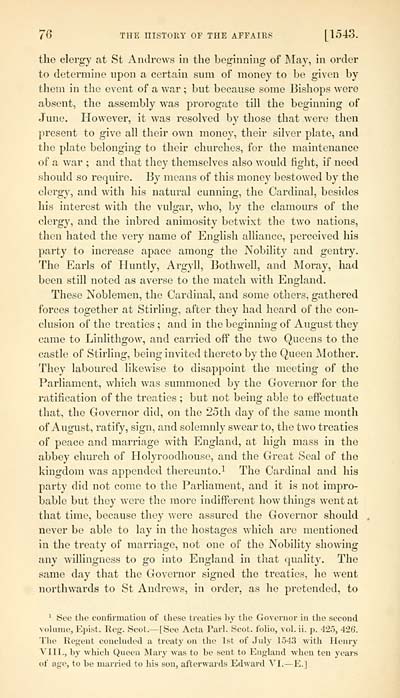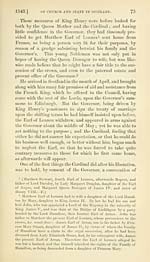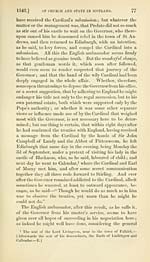Spottiswoode Society > History of the affairs of the Church and State of Scotland from the beginning of the reformation to the year 1568 > Volume 1
(212) Page 76
Download files
Complete book:
Individual page:
Thumbnail gallery: Grid view | List view

7C> THE HISTORY OF THE AFFAIRS [1543.
the clergy at St Andrews in the beginning of May, in order
to determine upon a certain sum of money to be given by
them in the event of a war ; but because some Bishops were
absent, the assembly was prorogate till the beginning of
June. However, it was resolved by those that were then
present to give all their own money, their silver plate, and
the plate belonging to their churches, for the maintenance
of a war ; and that they themselves also would fight, if need
.should so require. By means of this money bestowed by the
clergy, and with his natural cunning, the Cardinal, besides
his interest with the vulgar, who, by the clamours of the
clergy, and the inbred animosity betwixt the two nations,
then hated the very name of English alliance, perceived his
party to increase apace among the Nobility and gentry.
The Earls of Huntly, Argyll, Bothwell, and Moray, had
been still noted as averse to the match with England.
These Noblemen, the Cardinal, and some others, gathered
forces together at Stirling, after they had heard of the con-
clusion of the treaties ; and in the beginning of August they
came to Linlithgow, and carried off the two Queens to the
castle of Stirling, being invited thereto by the Queen Mother.
They laboured likewise to disappoint the meeting of the
Parliament, which was summoned by the Governor for the
ratification of the treaties ; but not being able to effectuate
that, the Governor did, on the 25th day of the same month
of August, ratify, sign, and solemnly swear to, the two treaties
of peace and marriage with England, at high mass in the
abbey church of Holyroodhouse, and the Great Seal of the
kingdom was appended thereunto. 1 The Cardinal and his
party did not come to the Parliament, and it is not impro-
bable but they were the more indifferent how things went at
that time, because they were assured the Governor should
never be able to lay in the hostages which are mentioned
in the treaty of marriage, not one of the Nobility showing
any willingness to go into England in that quality. The
same day that the Governor signed the treaties, he went
northwards to St Andrews, in order, as he pretended, to
1 See the confirmation of those treaties by the Governor in the second
volume, Epist. Reg. Scot. — [See Acta Pari. Scot, folio, vol. ii. p. 425, 426.
The Regent concluded a treaty on the 1st of July 1543 with Henry
VIII., by which Queen Mary was to be sent to England when ten years
of age, to be married to his son, afterwards Edward VI. — E.]
the clergy at St Andrews in the beginning of May, in order
to determine upon a certain sum of money to be given by
them in the event of a war ; but because some Bishops were
absent, the assembly was prorogate till the beginning of
June. However, it was resolved by those that were then
present to give all their own money, their silver plate, and
the plate belonging to their churches, for the maintenance
of a war ; and that they themselves also would fight, if need
.should so require. By means of this money bestowed by the
clergy, and with his natural cunning, the Cardinal, besides
his interest with the vulgar, who, by the clamours of the
clergy, and the inbred animosity betwixt the two nations,
then hated the very name of English alliance, perceived his
party to increase apace among the Nobility and gentry.
The Earls of Huntly, Argyll, Bothwell, and Moray, had
been still noted as averse to the match with England.
These Noblemen, the Cardinal, and some others, gathered
forces together at Stirling, after they had heard of the con-
clusion of the treaties ; and in the beginning of August they
came to Linlithgow, and carried off the two Queens to the
castle of Stirling, being invited thereto by the Queen Mother.
They laboured likewise to disappoint the meeting of the
Parliament, which was summoned by the Governor for the
ratification of the treaties ; but not being able to effectuate
that, the Governor did, on the 25th day of the same month
of August, ratify, sign, and solemnly swear to, the two treaties
of peace and marriage with England, at high mass in the
abbey church of Holyroodhouse, and the Great Seal of the
kingdom was appended thereunto. 1 The Cardinal and his
party did not come to the Parliament, and it is not impro-
bable but they were the more indifferent how things went at
that time, because they were assured the Governor should
never be able to lay in the hostages which are mentioned
in the treaty of marriage, not one of the Nobility showing
any willingness to go into England in that quality. The
same day that the Governor signed the treaties, he went
northwards to St Andrews, in order, as he pretended, to
1 See the confirmation of those treaties by the Governor in the second
volume, Epist. Reg. Scot. — [See Acta Pari. Scot, folio, vol. ii. p. 425, 426.
The Regent concluded a treaty on the 1st of July 1543 with Henry
VIII., by which Queen Mary was to be sent to England when ten years
of age, to be married to his son, afterwards Edward VI. — E.]
Set display mode to: Large image | Transcription
Images and transcriptions on this page, including medium image downloads, may be used under the Creative Commons Attribution 4.0 International Licence unless otherwise stated. ![]()
| Permanent URL | https://digital.nls.uk/79599332 |
|---|
| Description | Volume I. |
|---|---|
| Attribution and copyright: |
|

